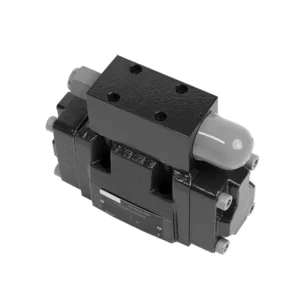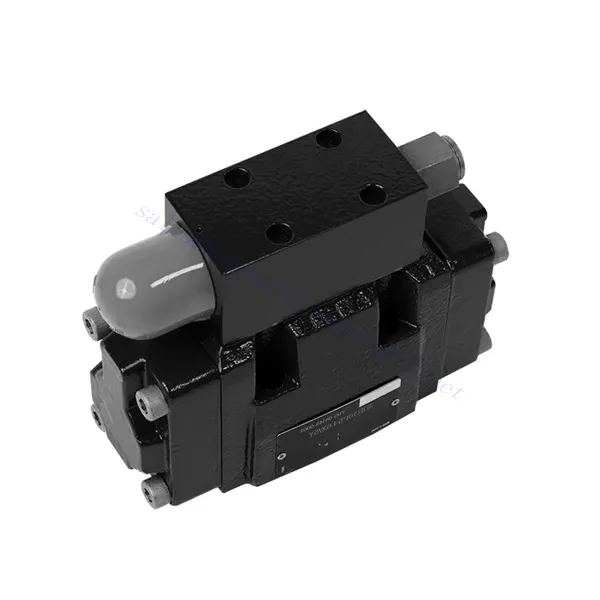3DR Series Pilot Operated Pressure Reducing Hydraulic Valve
Jako jeden z producentów, dostawców i eksporterów produktów mechanicznych, oferujemy cylindry hydrauliczne i wiele innych produktów.
Prosimy o kontakt w celu uzyskania szczegółowych informacji.
Poczta:sales@hydraulic-cylinders.net
Producent dostawca eksporter siłowników hydraulicznych.
3DR Series Pilot Operated Pressure Reducing Hydraulic Valve

The 3DR series pilot-operated pressure-reducing hydraulic valve is a highly efficient and reliable component that delivers precise pressure control in hydraulic systems. With its advanced pilot-operated mechanism and exceptional performance, this valve ensures an accurate reduction of hydraulic pressure to meet specific system requirements.
The 3DR series pilot-operated pressure-reducing hydraulic valve is a high-performance solution for precise pressure control in hydraulic systems. Featuring a pilot-operated design, precise pressure control, wide pressure range, and high flow capacity, this valve ensures efficient and accurate pressure reduction while safeguarding system components. By following the recommended usage methods and maintenance practices, the 3DR series valve delivers reliable performance, extending the lifespan of hydraulic systems. Upgrade your hydraulic system with the 3DR series pilot-operated pressure-reducing hydraulic valve and experience optimal pressure control for enhanced system efficiency and productivity.
3DR Series Pilot Operated Pressure Reducing Hydraulic Valve Key Characteristics:
- Pilot-Operated Design:
- The 3DR series valve features a pilot-operated design, which enables it to provide accurate, stable, and reliable pressure reduction in hydraulic systems.
- It utilizes a separate control circuit, known as the pilot circuit, to regulate the opening of the main valve and control the pressure.
- Precise Pressure Control:
- This valve offers exceptional precision in pressure control, allowing hydraulic systems to operate within the desired pressure limits.
- It maintains consistent pressure levels, preventing over-pressurization and safeguarding sensitive system components.
- Wide Pressure Range:
- The 3DR series valve is available in various pressure ranges, making it suitable for various hydraulic applications.
- The flexibility in pressure range allows customization to match specific system requirements and optimize performance.
- High Flow Capacity:
- This valve exhibits excellent flow capacity, enabling it to handle high flow rates without compromising pressure control accuracy.
- It ensures efficient fluid regulation and uninterrupted system operation, even in demanding applications.
3DR Series Pilot Operated Pressure Reducing Hydraulic Valve Parameter:
| Specifications | NG10 | NG16 | ||
| Fluid | Mineral oil suitable for NBR and FKM seal | |||
| Phosphate ester for FKM seal | ||||
| Fluid temperature range | ℃ | -30 to +80 (NBR seals) | ||
| -20 to +80 (FKM seals) | ||||
| Viscosity range | mm2/s | 10 to 800 | ||
| Degree of contamination | Maximum permissible degree of fluid contamination: Class 9. NAS 1638 or 20/18/15, ISO4406 | |||
| Nominal pressure | bar | 315 | ||
| Max. operating pressure | Port P | bar | 315 | |
| Max. operating pressure | Port A | bar | 315 | 250 |
| Max. operating pressure | Port Y | bar | Separate and at zero pressure to tank | |
| Setting pressure | Min. | bar | Dependent on the flow (see curves) | |
| Max. | bar | 50; 100; 200; 315 | 50; 100; 200; 250 | |
| Max. flow-rate | L/min | 120 | 220 | |
| Weight | kg | about 6.5 | about 8.8 | |
3DR Series Pilot Operated Pressure Reducing Hydraulic Valve Advantages:
• Installation face follows DIN 24340 A and ISO 4401
• Four pressure ranges
• Two adjustment types: knob, adjustment screw with protection cap
• With pressure gauge interface
Usage Method Of 3DR Series Pilot Operated Pressure Reducing Hydraulic Valve:
- System Analysis:
- Conduct a comprehensive hydraulic system analysis to determine the specific pressure control requirements.
- Consider maximum operating pressure, desired pressure range, and flow rates.
- Valve Selection:
- Select the appropriate 3DR series valve variant based on the system’s pressure control specifications.
- Consider pressure rating, flow capacity, and compatibility with other system components.
- Installation:
- Follow the manufacturer’s instructions to correctly install the 3DR series pilot-operated pressure-reducing valve in the hydraulic system.
- Ensure proper alignment and secure connections to prevent leaks and optimize performance.
- Calibration:
- Calibrate the valve to set the desired downstream pressure.
- Use pressure gauges or other measurement devices to adjust the valve’s pilot circuit accurately.
How Does A Hydraulic Rupture Valve Work?
A hydraulic rupture valve, also known as a burst or pressure relief valve, is a safety device designed to protect hydraulic systems from catastrophic failure in the event of a sudden pressure surge or hydraulic line rupture. Its primary function is to limit the pressure within the system by diverting excess fluid flow when a predetermined pressure threshold is exceeded. Let’s explore how a hydraulic rupture valve works:
- Valve Construction:
- A hydraulic rupture valve typically consists of a valve body, a spring-loaded poppet or spool, and an adjustable spring.
- The valve body contains fluid ports for the inlet, outlet, and a drain or return line to the reservoir.
- Pressure Setting:
- The rupture valve has an adjustable spring that determines the pressure at which the valve opens.
- By adjusting the spring tension, the pressure threshold at which the valve will activate can be set according to system requirements.
- Pressure Monitoring:
- As the hydraulic system operates, the pressure level is constantly monitored.
- The rupture valve is connected to the system at a strategic location, such as downstream of critical components or in high-pressure lines.
- Pressure Surge or Rupture Detection:
- If a sudden pressure surge occurs or a hydraulic line ruptures, the pressure within the system rapidly increases beyond the set threshold.
- Valve Activation:
- When the pressure exceeds the set threshold, the force exerted by the system pressure overcomes the spring tension.
- This force causes the rupture valve to open, creating a path for excess fluid to flow out of the system and either return to the reservoir or a designated drain line.
- Fluid Diversion:
- By diverting excess fluid flow, the rupture valve effectively limits the pressure within the system, preventing further pressure buildup.
- This safeguards system components from damage and minimizes the risk of catastrophic failure.
- Pressure Equalization:
- As the excess fluid is diverted, the pressure within the system begins to equalize.
- Once the pressure drops below the set threshold, the spring tension overcomes the force exerted by the system pressure, causing the valve to close.
- System Restoration:
- After the rupture valve has closed, the normal flow of hydraulic fluid through the system is restored.
- The system can continue to operate, albeit at a reduced pressure level, until the cause of the pressure surge or rupture is addressed.
Możliwości i pojemność fabryki:
(1) Montaż
Dysponujemy najwyższej klasy niezależną platformą badawczo-rozwojową. Warsztat produkcji siłowników hydraulicznych posiada cztery półautomatyczne linie montażowe siłowników podnoszących i jedną automatyczną linię montażową siłowników przechyłu, o projektowanej rocznej zdolności produkcyjnej 1 miliona sztuk. Specjalny warsztat cylindrów jest wyposażony w różne specyfikacje półautomatycznego systemu montażu czyszczącego o projektowanej rocznej zdolności produkcyjnej 200 000 i wyposażony w słynny sprzęt do obróbki CNC, centrum obróbcze, specjalny sprzęt do precyzyjnej obróbki cylindrów, robot spawalniczy, automatyczna maszyna czyszcząca, automatyczna maszyna do montażu cylindrów i automatyczna linia produkcyjna do malowania. Istniejący krytyczny sprzęt składa się z ponad 300 zestawów. Optymalna alokacja i efektywne wykorzystanie zasobów sprzętowych zapewniają wymagania dotyczące dokładności produktów i spełniają potrzeby wysokiej jakości produktów.


(2) Obróbka
Warsztat obróbki skrawaniem jest wyposażony w niestandardowe centrum tokarskie z pochyloną szyną, centrum obróbcze, szybkobieżną honownicę, robota spawalniczego i inny powiązany sprzęt, który może obsługiwać przetwarzanie rur cylindrycznych o maksymalnej średnicy wewnętrznej 400 mm i maksymalnej długości 6 metrów.

(3) Spawanie

(4) Malowanie i powlekanie
Z małymi i średnimi automatycznymi liniami do powlekania farbami na bazie wody, w celu osiągnięcia automatycznego załadunku i rozładunku robota oraz automatycznego natryskiwania, wydajność projektowa 4000 sztuk na zmianę;
Posiadamy również półautomatyczną linię do produkcji farb do dużych cylindrów napędzaną łańcuchem napędowym, o wydajności 60 skrzyń na zmianę.


(5) Testowanie
Dysponujemy najwyższej klasy urządzeniami kontrolnymi i stanowiskami testowymi, aby zapewnić, że wydajność cylindra spełnia wymagania.

We are one of the best hydraulic cylinder manufacturers. We can offer comprehensive hydraulic cylinders. We also provide corresponding przekładnie rolnicze. Eksportowaliśmy nasze produkty do klientów na całym świecie i zdobyliśmy dobrą reputację dzięki najwyższej jakości produktów i usług posprzedażnych. Zapraszamy klientów w kraju i za granicą do kontaktu z nami w celu negocjacji biznesowych, wymiany informacji i współpracować z nami!
Zapraszamy na wycieczkę po naszej fabryce VR:
Wybierz się na wycieczkę po naszej fabryce VR z następującymi elementami
Siłownik hydrauliczny Zastosowanie:


